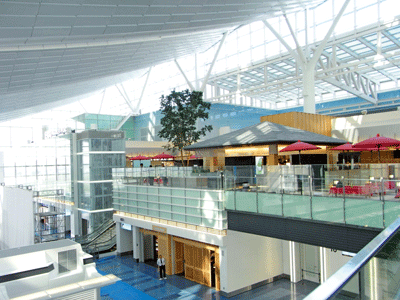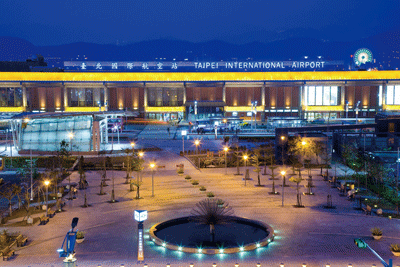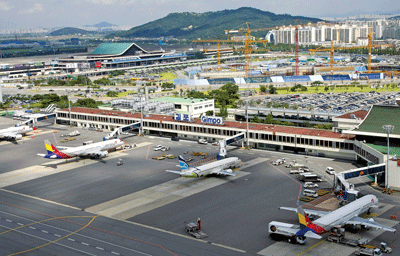Tokyo in the ‘60s, Taipei in the ‘70s and Shanghai and Seoul in the ‘90s shared one problem: their main airport was overcrowded but there was little viable land around it that could be used for expansion. So they all did the same thing: build a new airport at a location further out of the city.
Once the main international airports of their cities, Haneda Airport (now Tokyo International Airport), Taipei Songshan Airport, Shanghai Hongqiao International Airport and Seoul’s Gimpo Airport were all eventually downgraded to become domestic airports when bigger, newer facilities – in Narita, Taoyuan, Pudong and Incheon respectively – took over the international operations.

But not everyone was happy with that – in fact, very few travellers using the new airports were. Travelling between them and their respective city centres is often costly – and it’s certainly time-consuming. For someone travelling from Tokyo to Shanghai for a meeting on the same day, airport transfers alone would take three hours out of their schedule. And in the case of Narita, taking a cab is not a realistic option even if you are in a rush; it costs JPY21,000 (US$251) to reach Shinjuku or Shibuya, not including surcharges and tolls.
Much has happened since the new airports opened: the Chinese and South Korean economies have experienced phenomenal growth and cross-strait flights between mainland China and Taiwan have resumed after decades when they were suspended. That has resulted in rising demand for international business travel by air in the region – according to the International Air Transport Association, air traffic increased by 7.3 percent in Asia-Pacific in the year to October 2010 – and into the breach stepped Haneda, Honqiao, Songshan and Gimpo.
Yang Guo Feng, director of Taipei Songshan Airport at Taiwan’s Civil Aeronautics Administration, says the new routes “tap into the short distances [between] neighbouring countries and significantly increase commercial viability by integrating Taipei with three major cities in northeast Asia, providing with it opportunities for development”.
The view in Tokyo is similar. “Haneda aims to be the international 24-hour business hub airport catering to the high demand for flights to business cities in Asia,” says Masami Watanabe, deputy airport administrator of Tokyo International Airport at the Civil Aviation Bureau, Japan.
Downgraded former international airports in other parts of the world have also regained their international status. Milan’s Linate Airport, for example, located 7.8km southeast of Milan’s central business district, was the city’s primary air terminal until the opening of Malpensa Airport in 1998, nearly 40km from the city centre. Thanks to demand from business travellers, the airport again serves short-haul international flights in addition to domestic operations.
The need for an in-town airport in a commercial city is also illustrated by London City Airport (LCA), which was constructed specifically to cater to the needs of business travellers and serves the city’s central business district. A passenger at LCA can reach finance hub Canary Wharf in the same time it takes a passenger at Heathrow to get off the plane, through the airport’s passageways, past immigration and onto the Heathrow Express train platform – when he or she still hasn’t even left the airport.
Tokyo International Airport (Haneda Airport)
Once an international airport, the vast majority of Haneda’s overseas flights were transferred to Narita International Airport when the latter opened in 1978, as Haneda faced expansion troubles caused by insufficient runway lengths and technical limitations.

In the 1980s, the Tokyo Metropolitan Government began using the adjacent Tokyo Bay as a landfill and created land on which the airport could expand. A new runway was opened over the landfill in July 1988 and five years later, the old airport terminal was replaced by the West Passenger Terminal, now known as Terminal 1. Within eight years, two more runways and Terminal 2, housing ANA, Air Do and Star Flyer had also opened.
With the recent increase in air travel coupled with Narita’s international flight curfew between 11pm and 6am (part of the airport’s noise mitigation efforts), international flights were reinstated at Haneda last year and Haneda was expanded to handle the increase in capacity. Currently, Haneda offers international flights to 17 cities across the world, including Shanghai, Taipei, Hong Kong, Paris, London and Los Angeles.
A new international terminal and a fourth runway, Runway D were unveiled on October 21, 2010. The 2,500m runway extends from the shoreline, with two thirds of it resting on reclaimed land while the remainder sits on pylons drilled into Tokyo Bay. These new facilities are aimed at increasing the airport’s operational capacity from 306,000 flight slots a year to 447,000.
The new five-storey international terminal is equipped with 120 check-in counters, 40 self-service check-in machines, 10 boarding gates and facilities fitted to accommodate new aircraft models such as the Airbus A380. Passengers connecting to a domestic flight can check in at separate counters.
For entertainment, the terminal also features a planetarium and an Edo Marketplace modelled on a traditional Japanese street from the Edo period.
The international terminal is linked to the other two terminals and the city centre by the Tokyo Monorail and the Keikyu Airport Line. Shuttle buses between the terminals are available as well. The difficult time is after midnight, when the train and shuttle bus services stop, leaving passengers on flights arriving at Haneda between 11pm and 6am with no choice but to take a taxi to town. Luckily, unlike Narita, the ride from the airport to the city centre takes 15 minutes instead of 40, and is more affordable at JPY4,000 (US$48) to JPY10,000 (US$120).
“The proximity to central Tokyo as well as the availability of flights, even at midnight, makes it very convenient for passengers, especially business travellers,” says Yoichi Hirai, director of corporate planning of
the airport.
After the opening of the new international terminal, the number of passengers using Haneda leapt from 28,726 in September 2010 to 559,450 in November 2010.
Shanghai Hongqiao International Airport
In 2009, some 25 million passengers went through Shanghai Hongqiao International Airport. In order to handle the growing traffic, a second terminal, four times the size of Terminal 1, and a 3,300-metre runway were constructed, and opened on March 16, 2010.
The new facilities were a much-needed upgrade from the cramped Terminal 1, especially during the 2010 World Expo. The 362,600sqm terminal offers 45 boarding gates, 80 check-in counters, 47 security gates, a cross-city check-in service for passengers transferring to Pudong International Airport and even vending machines selling mobile phones with prepaid local SIM cards.
The two terminals and Shanghai’s city centre are connected by the Shanghai Metro. Passengers can travel on Metro Line 2 from downtown Shanghai to Hongqiao’s Terminal 2 within half an hour. The same route also goes to Pudong International Airport, but takes twice as long.
International flights to Tokyo International Airport started on September 29, 2007, and to Gimpo International Airport on October 28 in the same year. Last year, routes opened to Taipei Songshan Airport in June and Hong Kong International Airport in September.
“The reintroduction of [international flights] has definitely impacted me both personally and professionally in a positive way,” says Alfonso Romero, general manager of Gran Meliá Shanghai Hotel. “Now, I have a lot more flight options and need not connect only at Pudong International Airport. Professionally, it is certainly beneficial to Shanghai as a city and for my hotel located in Shanghai to receive incremental international travellers from these key feeder markets.”
Taipei Songshan Airport
Taipei Songshan Airport is going through changes. Both Terminal I and II are being reconstructed to support the surge in traffic and are scheduled for completion in October 2011. The renovation project includes replacing eight boarding bridges so as to accommodate larger-sized planes such as the Boeing 767. When it’s complete, Terminal I will be used for international flights while Terminal II will serve domestic flights.
Currently, Songshan offers travellers convenient international routes to Tokyo International Aiport (Haneda) and Shanghai Hongqiao International Airport. Connections with Seoul’s Gimpo International Airport are still in the works.

“These international flights are part of the northeast Asia Golden Flight-route Circuit plan [of Taiwanese President Ma Ying-jeou] to transform Songshan Airport into an important part of the northeast Asian transportation ring by linking it to northeast Asia’s most important, prosperous and vibrant metropolises,” says Yang.
“For a business traveller, time is the most important thing. Travel between these three cities could be reduced to day trips. From Taipei, one could take the subway to Songshan Airport in the morning, lunch on crabs in Shanghai at noon and sip tea in Tokyo in the afternoon.
If an agreement can be reached with South Korea on Gimpo Airport, dining on ginseng chicken in Myeong-dong will be a possibility too.”
Taipei-based James C Hou, a frequent flyer since 1981, says that “the opening of international flights from Songshan Airport has eased the rush and stress of travelling to or from the airport.”
Previously, for Hou to travel from Taipei to Shanghai, he would have had to make a one-hour journey to outlying Taiwan Taoyuan International Airport – four times the journey to Taipei Songshan Airport. He would then board a two-hour flight to Shanghai Pudong International Airport and make another one-hour commute to Shanghai’s city centre 40km away.
As of June 15, 2010, that was a thing of the past. With Songshan’s direct route to Shanghai Hongqiao International Airport, he saves at least an hour and a half of travelling time.
Gimpo International Airport
Located only 16km from Seoul’s city centre, Gimpo International Airport is 30 minutes away from the city by subway – a third of the journey to Seoul’s primary airport, Incheon.
Before Incheon opened in 2001, Gimpo housed two international terminals and one domestic one. After international flights were transferred to Incheon, Gimpo’s international terminal was converted to a domestic terminal. In 2002, one of the domestic terminals was turned into a shopping mall, the three-storey E-Mart, which offers fashion apparel, accessories, groceries and a wide selection of other merchandise.

In 2003, Gimpo International Airport started international flights to Tokyo International Airport (Haneda). Since then three other international routes have been added: to Shanghai Hongqiao International Airport in 2007, to Osaka’s Kansai International Airport in 2008, and to Nagoya’s Chubu Centrair International Airport in 2010.
Tokyo International Airport
Opened: Began international operations in 1947
Terminals: Three terminals – domestic JAL flights operate from Terminal 1, domestic ANA flights operate from Terminal 2 and the International Terminal handles international flights
Size: 15,220,000sqm
Destinations: 46 domestic and 17 international destinations
Flights Per Week: 7,056 flights per week
Airlines: 26
Distance from city centre: 15km
Shanghai Hongqiao International Airport
Opened: Opened to public in 1963
Terminals: Two terminals
Size: 36,260sqm
Destinations: 85 domestic and 56 international destinations
Flights Per Week: 3,780 flights per week
Airlines: 25
Distance from city centre: 13km
Taipei Songshan Airport
Opened: Opened to public in 1950
Terminals: Two terminals, Terminal 1 will be used for international flights, while Terminal 2 will serve domestic flights
Size: 1,820,000sqm
Destinations: 9 domestic and 11 international destinations
Flights Per Week: 980
Airlines: 12
Distance from city centre: 3km
Gimpo Airport
Opened: Opened to public in 1958
Terminals: Two terminals – an international terminal and a domestic terminal
Size: 1,221,713sqm
Destinations: 15 domestic 27 international destinations
Flights Per Week: 2,440
Airlines: 14
Distance from city centre: 16km








